Alhokair Fashion Retail Company: Change Initiative and Analysis Report
VerifiedAdded on 2022/09/25
|9
|2808
|18
Report
AI Summary
This report provides a comprehensive analysis of Alhokair Fashion Retail Company, a prominent player in the global fashion retail industry. It begins with an introduction to the company, its history, and its position in the market, followed by an overview of its organizational profile and structure, highlighting its centralized nature and key management roles. The report then delves into the change drivers affecting the company, particularly emphasizing the need for technological advancements and improvements in staff management. It identifies key stakeholders, including consumers, staff, and management, and outlines a change initiative overview, focusing on addressing issues such as slow decision-making, inadequate compensation schemes, and a lack of professional organizational culture. The report further examines key success factors related to staff training and development, as well as customer facilitation through technology. It details the change initiative process, emphasizing the importance of top-level management support, and analyzes potential stakeholder reactions to proposed changes. Finally, the report concludes with an evaluation and assessment of the company's activities, underscoring the significance of customer focus, product franchising, and the application of technology to enhance sales. This detailed analysis offers valuable insights into the challenges and opportunities facing Alhokair Fashion Retail Company and provides a framework for future improvements.
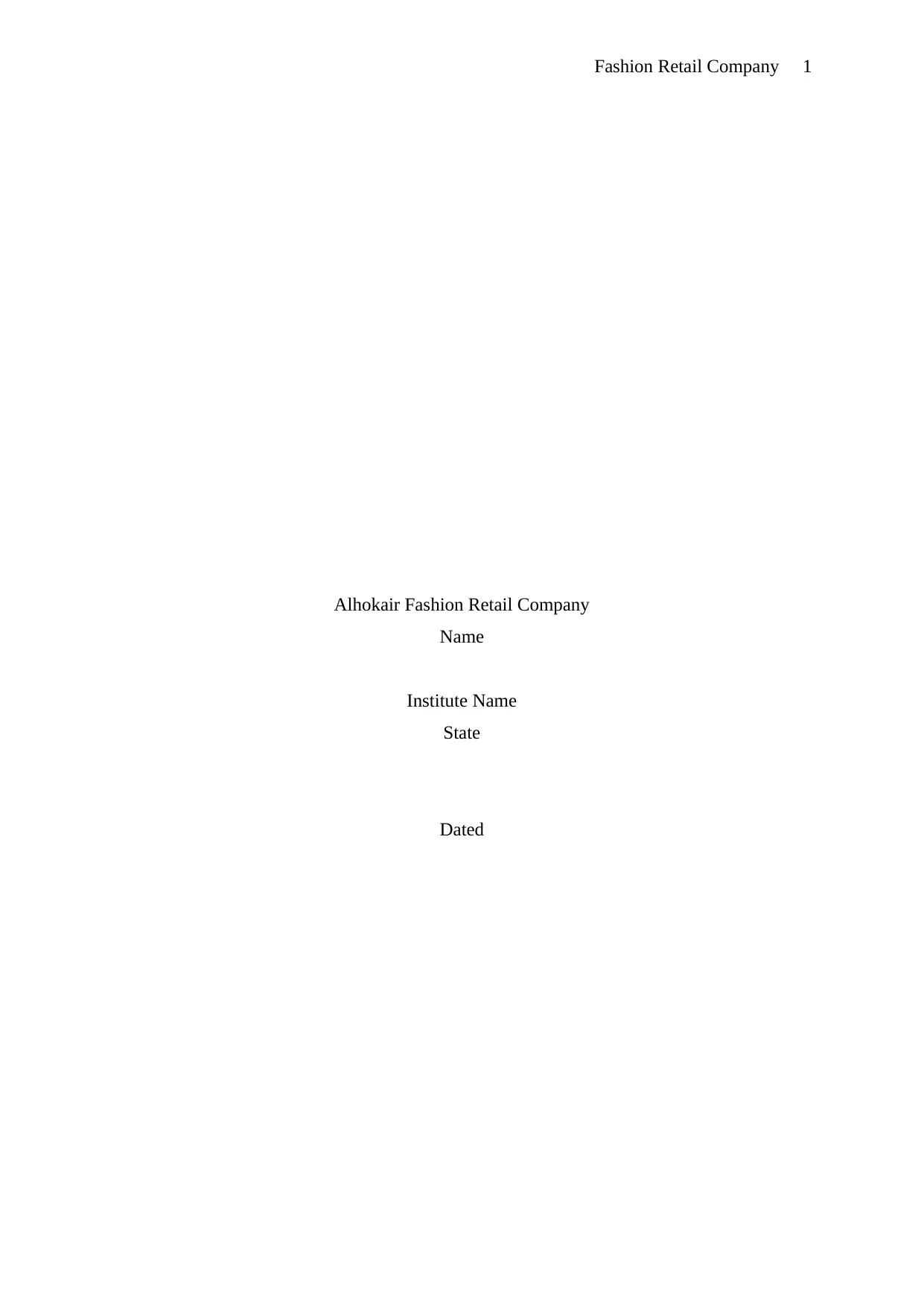
Fashion Retail Company 1
Alhokair Fashion Retail Company
Name
Institute Name
State
Dated
Alhokair Fashion Retail Company
Name
Institute Name
State
Dated
Paraphrase This Document
Need a fresh take? Get an instant paraphrase of this document with our AI Paraphraser
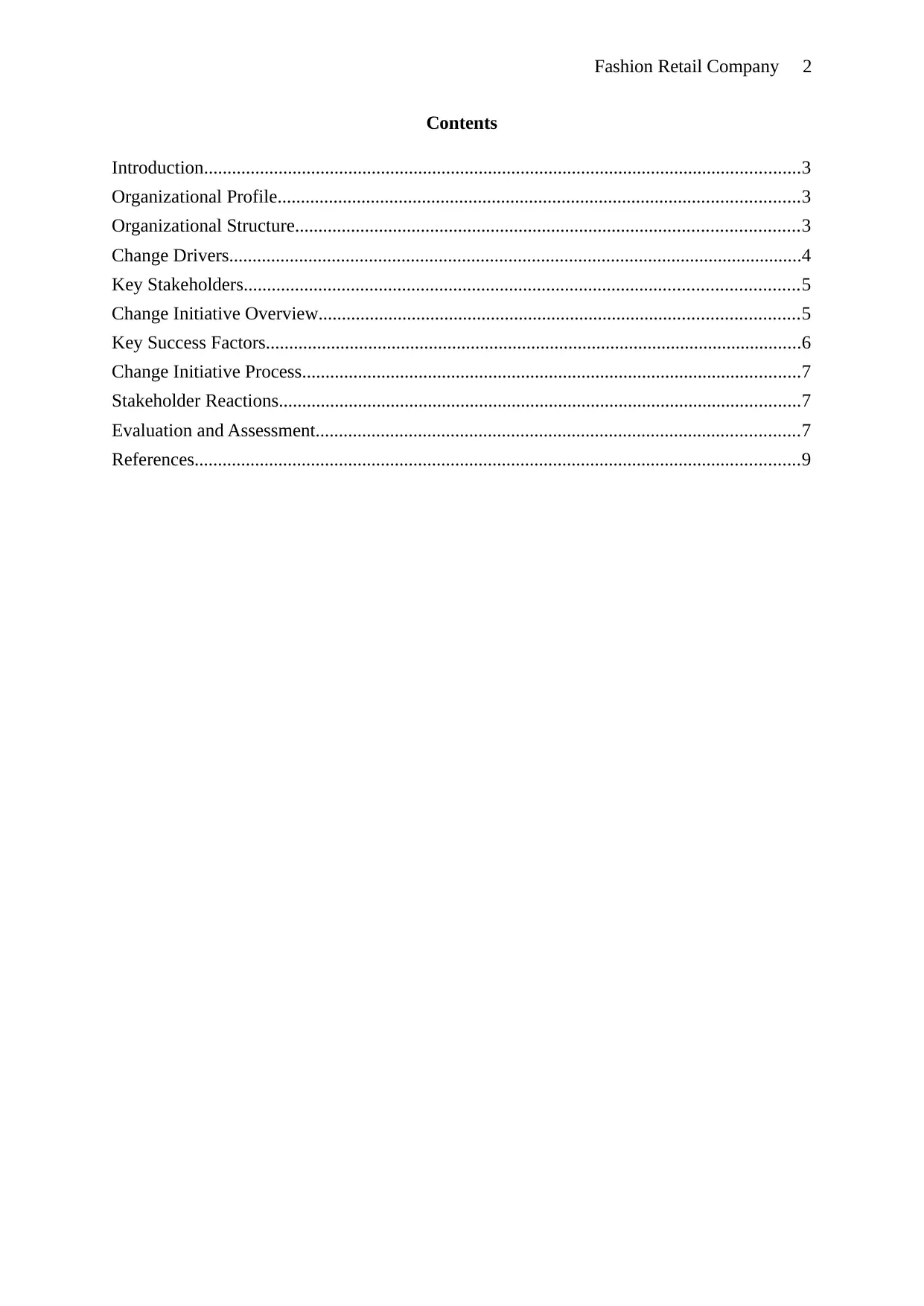
Fashion Retail Company 2
Contents
Introduction................................................................................................................................3
Organizational Profile................................................................................................................3
Organizational Structure............................................................................................................3
Change Drivers...........................................................................................................................4
Key Stakeholders.......................................................................................................................5
Change Initiative Overview.......................................................................................................5
Key Success Factors...................................................................................................................6
Change Initiative Process...........................................................................................................7
Stakeholder Reactions................................................................................................................7
Evaluation and Assessment........................................................................................................7
References..................................................................................................................................9
Contents
Introduction................................................................................................................................3
Organizational Profile................................................................................................................3
Organizational Structure............................................................................................................3
Change Drivers...........................................................................................................................4
Key Stakeholders.......................................................................................................................5
Change Initiative Overview.......................................................................................................5
Key Success Factors...................................................................................................................6
Change Initiative Process...........................................................................................................7
Stakeholder Reactions................................................................................................................7
Evaluation and Assessment........................................................................................................7
References..................................................................................................................................9
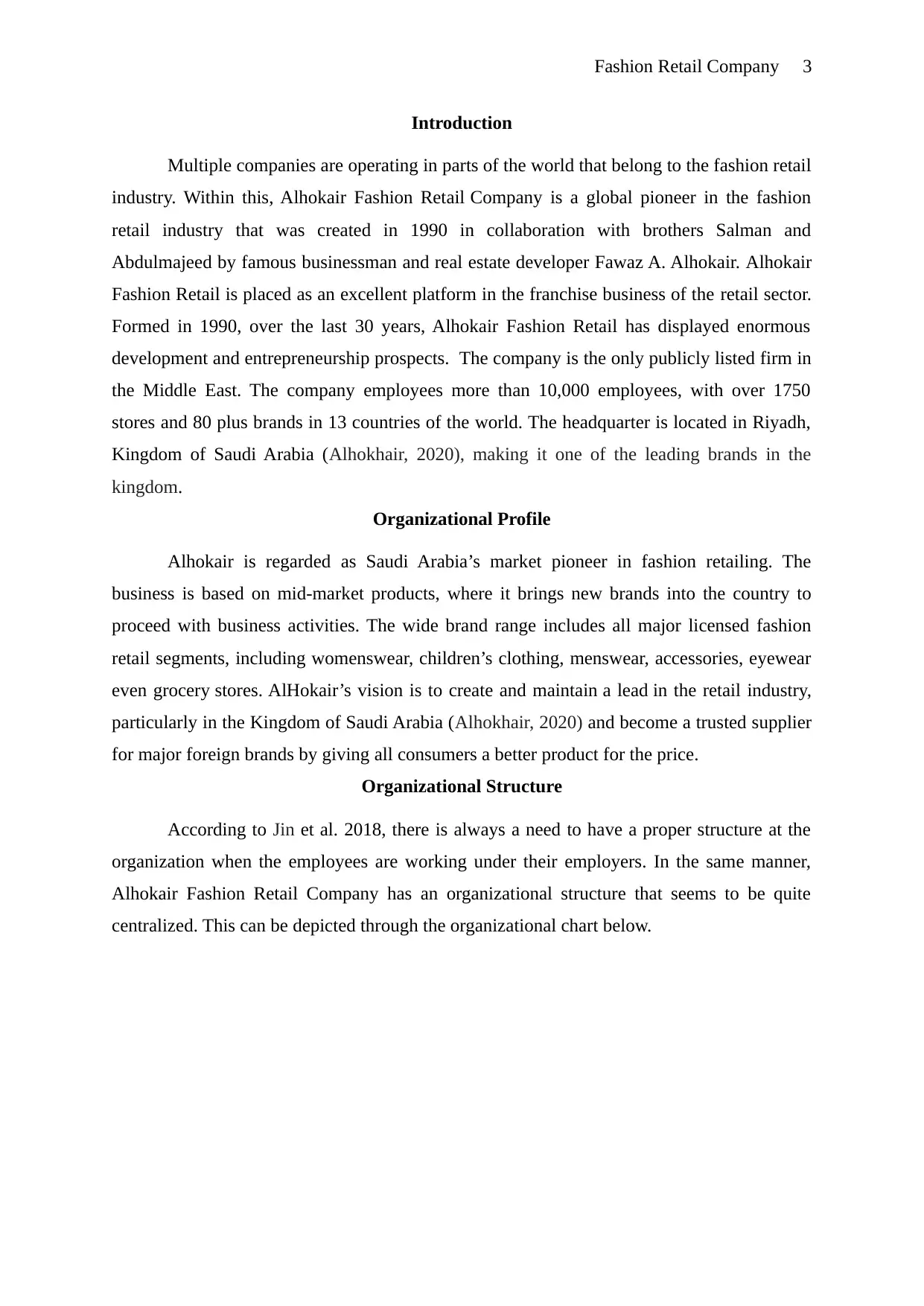
Fashion Retail Company 3
Introduction
Multiple companies are operating in parts of the world that belong to the fashion retail
industry. Within this, Alhokair Fashion Retail Company is a global pioneer in the fashion
retail industry that was created in 1990 in collaboration with brothers Salman and
Abdulmajeed by famous businessman and real estate developer Fawaz A. Alhokair. Alhokair
Fashion Retail is placed as an excellent platform in the franchise business of the retail sector.
Formed in 1990, over the last 30 years, Alhokair Fashion Retail has displayed enormous
development and entrepreneurship prospects. The company is the only publicly listed firm in
the Middle East. The company employees more than 10,000 employees, with over 1750
stores and 80 plus brands in 13 countries of the world. The headquarter is located in Riyadh,
Kingdom of Saudi Arabia (Alhokhair, 2020), making it one of the leading brands in the
kingdom.
Organizational Profile
Alhokair is regarded as Saudi Arabia’s market pioneer in fashion retailing. The
business is based on mid-market products, where it brings new brands into the country to
proceed with business activities. The wide brand range includes all major licensed fashion
retail segments, including womenswear, children’s clothing, menswear, accessories, eyewear
even grocery stores. AlHokair’s vision is to create and maintain a lead in the retail industry,
particularly in the Kingdom of Saudi Arabia (Alhokhair, 2020) and become a trusted supplier
for major foreign brands by giving all consumers a better product for the price.
Organizational Structure
According to Jin et al. 2018, there is always a need to have a proper structure at the
organization when the employees are working under their employers. In the same manner,
Alhokair Fashion Retail Company has an organizational structure that seems to be quite
centralized. This can be depicted through the organizational chart below.
Introduction
Multiple companies are operating in parts of the world that belong to the fashion retail
industry. Within this, Alhokair Fashion Retail Company is a global pioneer in the fashion
retail industry that was created in 1990 in collaboration with brothers Salman and
Abdulmajeed by famous businessman and real estate developer Fawaz A. Alhokair. Alhokair
Fashion Retail is placed as an excellent platform in the franchise business of the retail sector.
Formed in 1990, over the last 30 years, Alhokair Fashion Retail has displayed enormous
development and entrepreneurship prospects. The company is the only publicly listed firm in
the Middle East. The company employees more than 10,000 employees, with over 1750
stores and 80 plus brands in 13 countries of the world. The headquarter is located in Riyadh,
Kingdom of Saudi Arabia (Alhokhair, 2020), making it one of the leading brands in the
kingdom.
Organizational Profile
Alhokair is regarded as Saudi Arabia’s market pioneer in fashion retailing. The
business is based on mid-market products, where it brings new brands into the country to
proceed with business activities. The wide brand range includes all major licensed fashion
retail segments, including womenswear, children’s clothing, menswear, accessories, eyewear
even grocery stores. AlHokair’s vision is to create and maintain a lead in the retail industry,
particularly in the Kingdom of Saudi Arabia (Alhokhair, 2020) and become a trusted supplier
for major foreign brands by giving all consumers a better product for the price.
Organizational Structure
According to Jin et al. 2018, there is always a need to have a proper structure at the
organization when the employees are working under their employers. In the same manner,
Alhokair Fashion Retail Company has an organizational structure that seems to be quite
centralized. This can be depicted through the organizational chart below.
⊘ This is a preview!⊘
Do you want full access?
Subscribe today to unlock all pages.

Trusted by 1+ million students worldwide
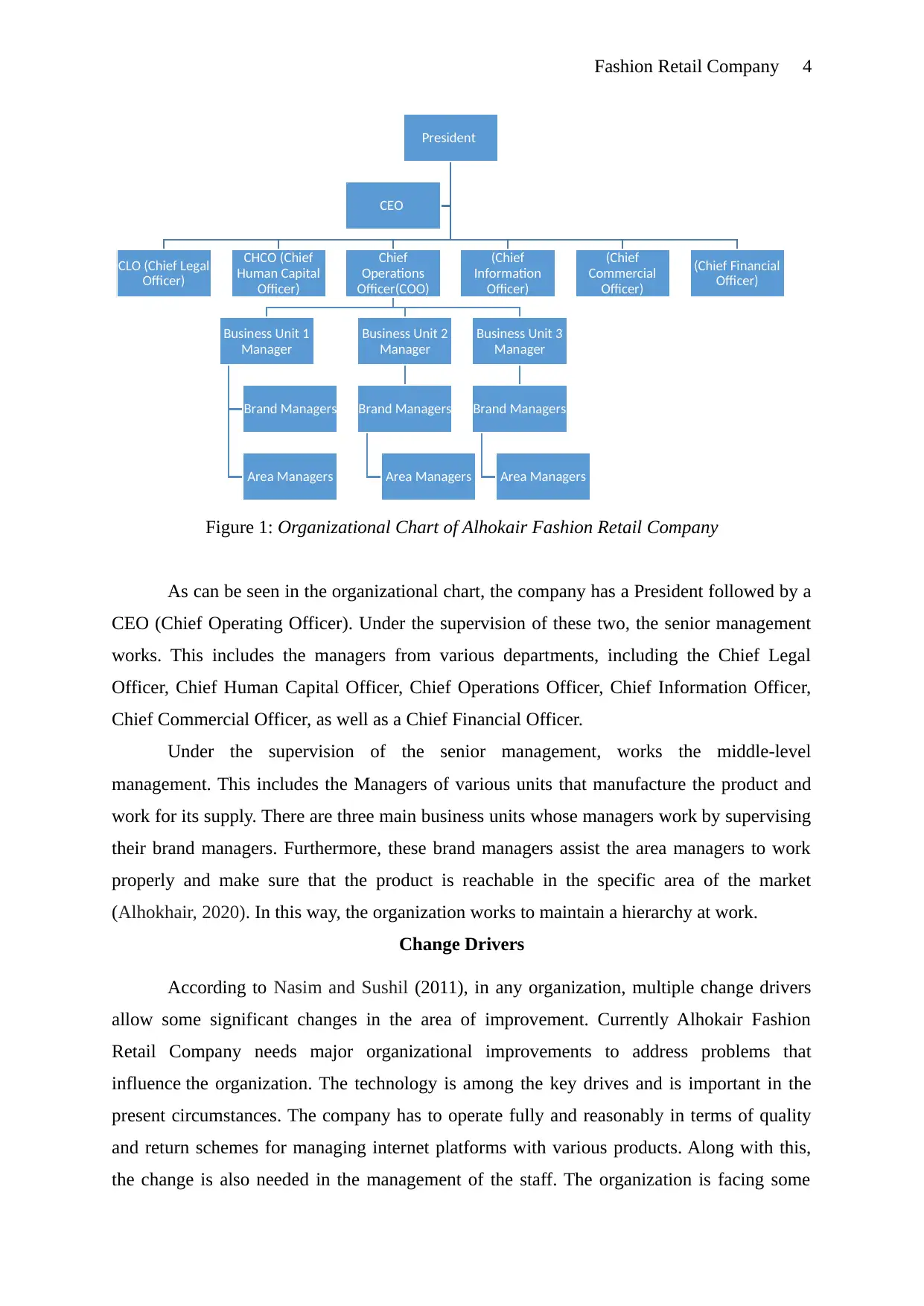
Fashion Retail Company 4
Figure 1: Organizational Chart of Alhokair Fashion Retail Company
As can be seen in the organizational chart, the company has a President followed by a
CEO (Chief Operating Officer). Under the supervision of these two, the senior management
works. This includes the managers from various departments, including the Chief Legal
Officer, Chief Human Capital Officer, Chief Operations Officer, Chief Information Officer,
Chief Commercial Officer, as well as a Chief Financial Officer.
Under the supervision of the senior management, works the middle-level
management. This includes the Managers of various units that manufacture the product and
work for its supply. There are three main business units whose managers work by supervising
their brand managers. Furthermore, these brand managers assist the area managers to work
properly and make sure that the product is reachable in the specific area of the market
(Alhokhair, 2020). In this way, the organization works to maintain a hierarchy at work.
Change Drivers
According to Nasim and Sushil (2011), in any organization, multiple change drivers
allow some significant changes in the area of improvement. Currently Alhokair Fashion
Retail Company needs major organizational improvements to address problems that
influence the organization. The technology is among the key drives and is important in the
present circumstances. The company has to operate fully and reasonably in terms of quality
and return schemes for managing internet platforms with various products. Along with this,
the change is also needed in the management of the staff. The organization is facing some
President
CLO (Chief Legal
Officer)
CHCO (Chief
Human Capital
Officer)
Chief
Operations
Officer(COO)
Business Unit 1
Manager
Brand Managers
Area Managers
Business Unit 2
Manager
Brand Managers
Area Managers
Business Unit 3
Manager
Brand Managers
Area Managers
(Chief
Information
Officer)
(Chief
Commercial
Officer)
(Chief Financial
Officer)
CEO
Figure 1: Organizational Chart of Alhokair Fashion Retail Company
As can be seen in the organizational chart, the company has a President followed by a
CEO (Chief Operating Officer). Under the supervision of these two, the senior management
works. This includes the managers from various departments, including the Chief Legal
Officer, Chief Human Capital Officer, Chief Operations Officer, Chief Information Officer,
Chief Commercial Officer, as well as a Chief Financial Officer.
Under the supervision of the senior management, works the middle-level
management. This includes the Managers of various units that manufacture the product and
work for its supply. There are three main business units whose managers work by supervising
their brand managers. Furthermore, these brand managers assist the area managers to work
properly and make sure that the product is reachable in the specific area of the market
(Alhokhair, 2020). In this way, the organization works to maintain a hierarchy at work.
Change Drivers
According to Nasim and Sushil (2011), in any organization, multiple change drivers
allow some significant changes in the area of improvement. Currently Alhokair Fashion
Retail Company needs major organizational improvements to address problems that
influence the organization. The technology is among the key drives and is important in the
present circumstances. The company has to operate fully and reasonably in terms of quality
and return schemes for managing internet platforms with various products. Along with this,
the change is also needed in the management of the staff. The organization is facing some
President
CLO (Chief Legal
Officer)
CHCO (Chief
Human Capital
Officer)
Chief
Operations
Officer(COO)
Business Unit 1
Manager
Brand Managers
Area Managers
Business Unit 2
Manager
Brand Managers
Area Managers
Business Unit 3
Manager
Brand Managers
Area Managers
(Chief
Information
Officer)
(Chief
Commercial
Officer)
(Chief Financial
Officer)
CEO
Paraphrase This Document
Need a fresh take? Get an instant paraphrase of this document with our AI Paraphraser
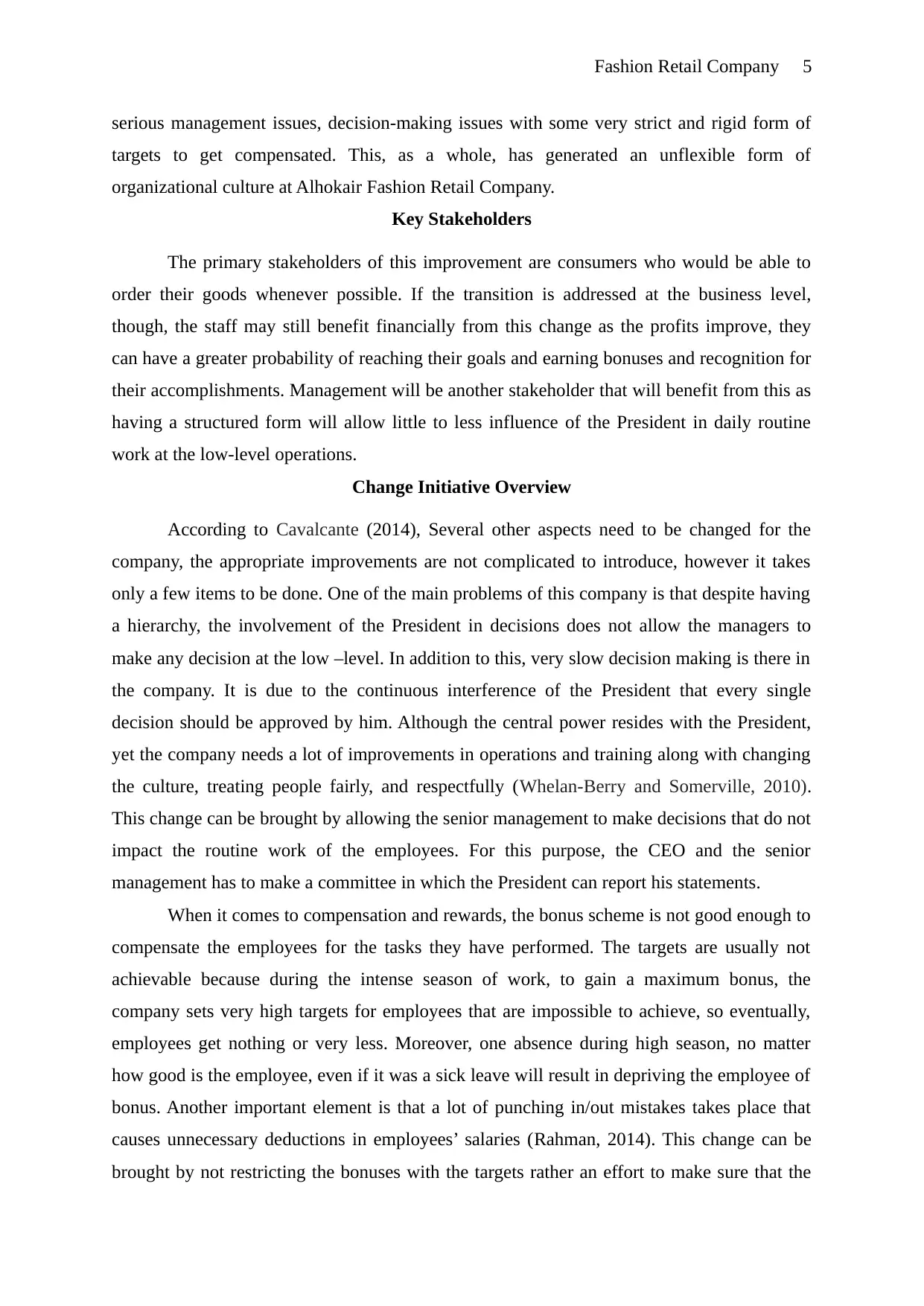
Fashion Retail Company 5
serious management issues, decision-making issues with some very strict and rigid form of
targets to get compensated. This, as a whole, has generated an unflexible form of
organizational culture at Alhokair Fashion Retail Company.
Key Stakeholders
The primary stakeholders of this improvement are consumers who would be able to
order their goods whenever possible. If the transition is addressed at the business level,
though, the staff may still benefit financially from this change as the profits improve, they
can have a greater probability of reaching their goals and earning bonuses and recognition for
their accomplishments. Management will be another stakeholder that will benefit from this as
having a structured form will allow little to less influence of the President in daily routine
work at the low-level operations.
Change Initiative Overview
According to Cavalcante (2014), Several other aspects need to be changed for the
company, the appropriate improvements are not complicated to introduce, however it takes
only a few items to be done. One of the main problems of this company is that despite having
a hierarchy, the involvement of the President in decisions does not allow the managers to
make any decision at the low –level. In addition to this, very slow decision making is there in
the company. It is due to the continuous interference of the President that every single
decision should be approved by him. Although the central power resides with the President,
yet the company needs a lot of improvements in operations and training along with changing
the culture, treating people fairly, and respectfully (Whelan-Berry and Somerville, 2010).
This change can be brought by allowing the senior management to make decisions that do not
impact the routine work of the employees. For this purpose, the CEO and the senior
management has to make a committee in which the President can report his statements.
When it comes to compensation and rewards, the bonus scheme is not good enough to
compensate the employees for the tasks they have performed. The targets are usually not
achievable because during the intense season of work, to gain a maximum bonus, the
company sets very high targets for employees that are impossible to achieve, so eventually,
employees get nothing or very less. Moreover, one absence during high season, no matter
how good is the employee, even if it was a sick leave will result in depriving the employee of
bonus. Another important element is that a lot of punching in/out mistakes takes place that
causes unnecessary deductions in employees’ salaries (Rahman, 2014). This change can be
brought by not restricting the bonuses with the targets rather an effort to make sure that the
serious management issues, decision-making issues with some very strict and rigid form of
targets to get compensated. This, as a whole, has generated an unflexible form of
organizational culture at Alhokair Fashion Retail Company.
Key Stakeholders
The primary stakeholders of this improvement are consumers who would be able to
order their goods whenever possible. If the transition is addressed at the business level,
though, the staff may still benefit financially from this change as the profits improve, they
can have a greater probability of reaching their goals and earning bonuses and recognition for
their accomplishments. Management will be another stakeholder that will benefit from this as
having a structured form will allow little to less influence of the President in daily routine
work at the low-level operations.
Change Initiative Overview
According to Cavalcante (2014), Several other aspects need to be changed for the
company, the appropriate improvements are not complicated to introduce, however it takes
only a few items to be done. One of the main problems of this company is that despite having
a hierarchy, the involvement of the President in decisions does not allow the managers to
make any decision at the low –level. In addition to this, very slow decision making is there in
the company. It is due to the continuous interference of the President that every single
decision should be approved by him. Although the central power resides with the President,
yet the company needs a lot of improvements in operations and training along with changing
the culture, treating people fairly, and respectfully (Whelan-Berry and Somerville, 2010).
This change can be brought by allowing the senior management to make decisions that do not
impact the routine work of the employees. For this purpose, the CEO and the senior
management has to make a committee in which the President can report his statements.
When it comes to compensation and rewards, the bonus scheme is not good enough to
compensate the employees for the tasks they have performed. The targets are usually not
achievable because during the intense season of work, to gain a maximum bonus, the
company sets very high targets for employees that are impossible to achieve, so eventually,
employees get nothing or very less. Moreover, one absence during high season, no matter
how good is the employee, even if it was a sick leave will result in depriving the employee of
bonus. Another important element is that a lot of punching in/out mistakes takes place that
causes unnecessary deductions in employees’ salaries (Rahman, 2014). This change can be
brought by not restricting the bonuses with the targets rather an effort to make sure that the
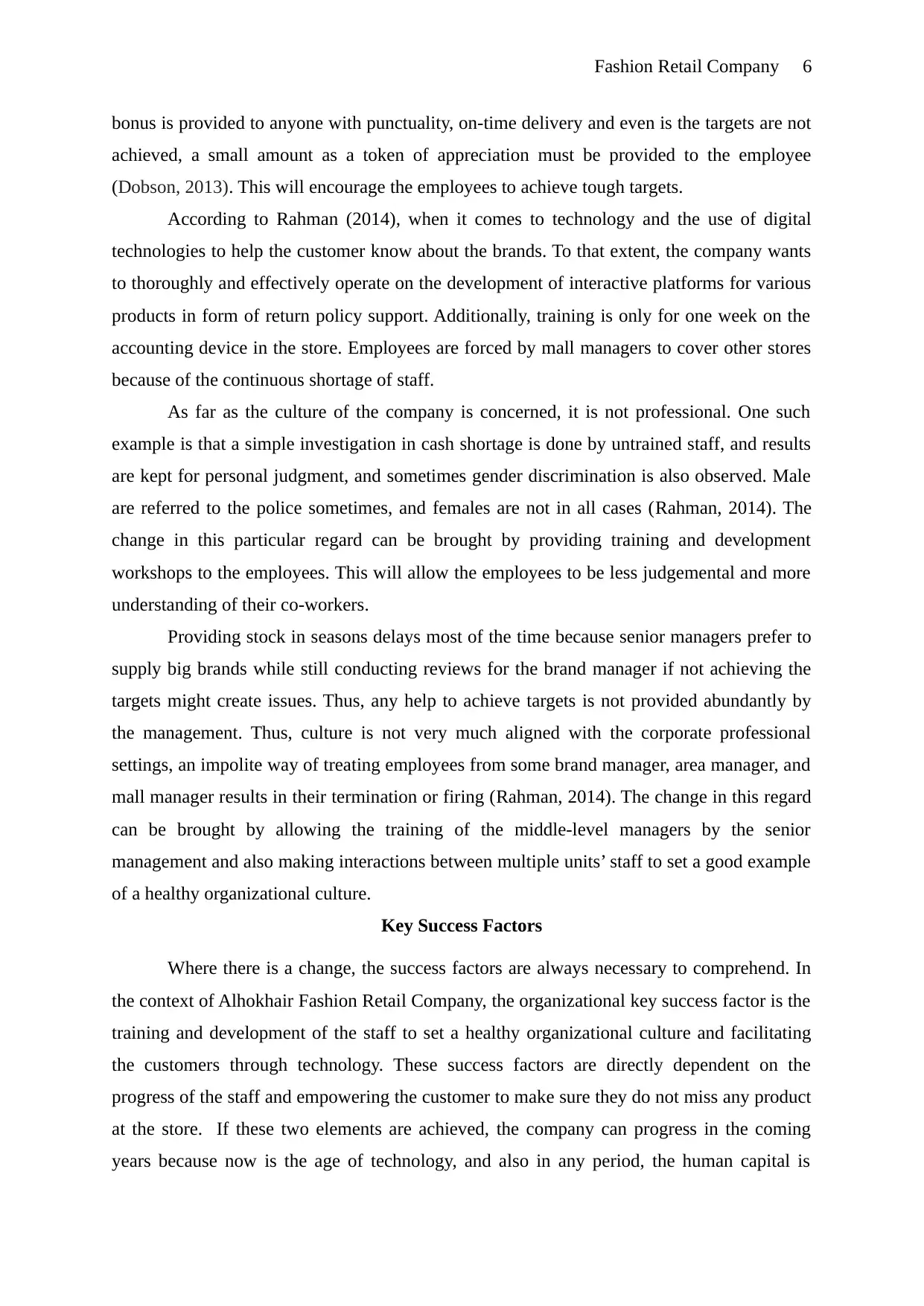
Fashion Retail Company 6
bonus is provided to anyone with punctuality, on-time delivery and even is the targets are not
achieved, a small amount as a token of appreciation must be provided to the employee
(Dobson, 2013). This will encourage the employees to achieve tough targets.
According to Rahman (2014), when it comes to technology and the use of digital
technologies to help the customer know about the brands. To that extent, the company wants
to thoroughly and effectively operate on the development of interactive platforms for various
products in form of return policy support. Additionally, training is only for one week on the
accounting device in the store. Employees are forced by mall managers to cover other stores
because of the continuous shortage of staff.
As far as the culture of the company is concerned, it is not professional. One such
example is that a simple investigation in cash shortage is done by untrained staff, and results
are kept for personal judgment, and sometimes gender discrimination is also observed. Male
are referred to the police sometimes, and females are not in all cases (Rahman, 2014). The
change in this particular regard can be brought by providing training and development
workshops to the employees. This will allow the employees to be less judgemental and more
understanding of their co-workers.
Providing stock in seasons delays most of the time because senior managers prefer to
supply big brands while still conducting reviews for the brand manager if not achieving the
targets might create issues. Thus, any help to achieve targets is not provided abundantly by
the management. Thus, culture is not very much aligned with the corporate professional
settings, an impolite way of treating employees from some brand manager, area manager, and
mall manager results in their termination or firing (Rahman, 2014). The change in this regard
can be brought by allowing the training of the middle-level managers by the senior
management and also making interactions between multiple units’ staff to set a good example
of a healthy organizational culture.
Key Success Factors
Where there is a change, the success factors are always necessary to comprehend. In
the context of Alhokhair Fashion Retail Company, the organizational key success factor is the
training and development of the staff to set a healthy organizational culture and facilitating
the customers through technology. These success factors are directly dependent on the
progress of the staff and empowering the customer to make sure they do not miss any product
at the store. If these two elements are achieved, the company can progress in the coming
years because now is the age of technology, and also in any period, the human capital is
bonus is provided to anyone with punctuality, on-time delivery and even is the targets are not
achieved, a small amount as a token of appreciation must be provided to the employee
(Dobson, 2013). This will encourage the employees to achieve tough targets.
According to Rahman (2014), when it comes to technology and the use of digital
technologies to help the customer know about the brands. To that extent, the company wants
to thoroughly and effectively operate on the development of interactive platforms for various
products in form of return policy support. Additionally, training is only for one week on the
accounting device in the store. Employees are forced by mall managers to cover other stores
because of the continuous shortage of staff.
As far as the culture of the company is concerned, it is not professional. One such
example is that a simple investigation in cash shortage is done by untrained staff, and results
are kept for personal judgment, and sometimes gender discrimination is also observed. Male
are referred to the police sometimes, and females are not in all cases (Rahman, 2014). The
change in this particular regard can be brought by providing training and development
workshops to the employees. This will allow the employees to be less judgemental and more
understanding of their co-workers.
Providing stock in seasons delays most of the time because senior managers prefer to
supply big brands while still conducting reviews for the brand manager if not achieving the
targets might create issues. Thus, any help to achieve targets is not provided abundantly by
the management. Thus, culture is not very much aligned with the corporate professional
settings, an impolite way of treating employees from some brand manager, area manager, and
mall manager results in their termination or firing (Rahman, 2014). The change in this regard
can be brought by allowing the training of the middle-level managers by the senior
management and also making interactions between multiple units’ staff to set a good example
of a healthy organizational culture.
Key Success Factors
Where there is a change, the success factors are always necessary to comprehend. In
the context of Alhokhair Fashion Retail Company, the organizational key success factor is the
training and development of the staff to set a healthy organizational culture and facilitating
the customers through technology. These success factors are directly dependent on the
progress of the staff and empowering the customer to make sure they do not miss any product
at the store. If these two elements are achieved, the company can progress in the coming
years because now is the age of technology, and also in any period, the human capital is
⊘ This is a preview!⊘
Do you want full access?
Subscribe today to unlock all pages.

Trusted by 1+ million students worldwide
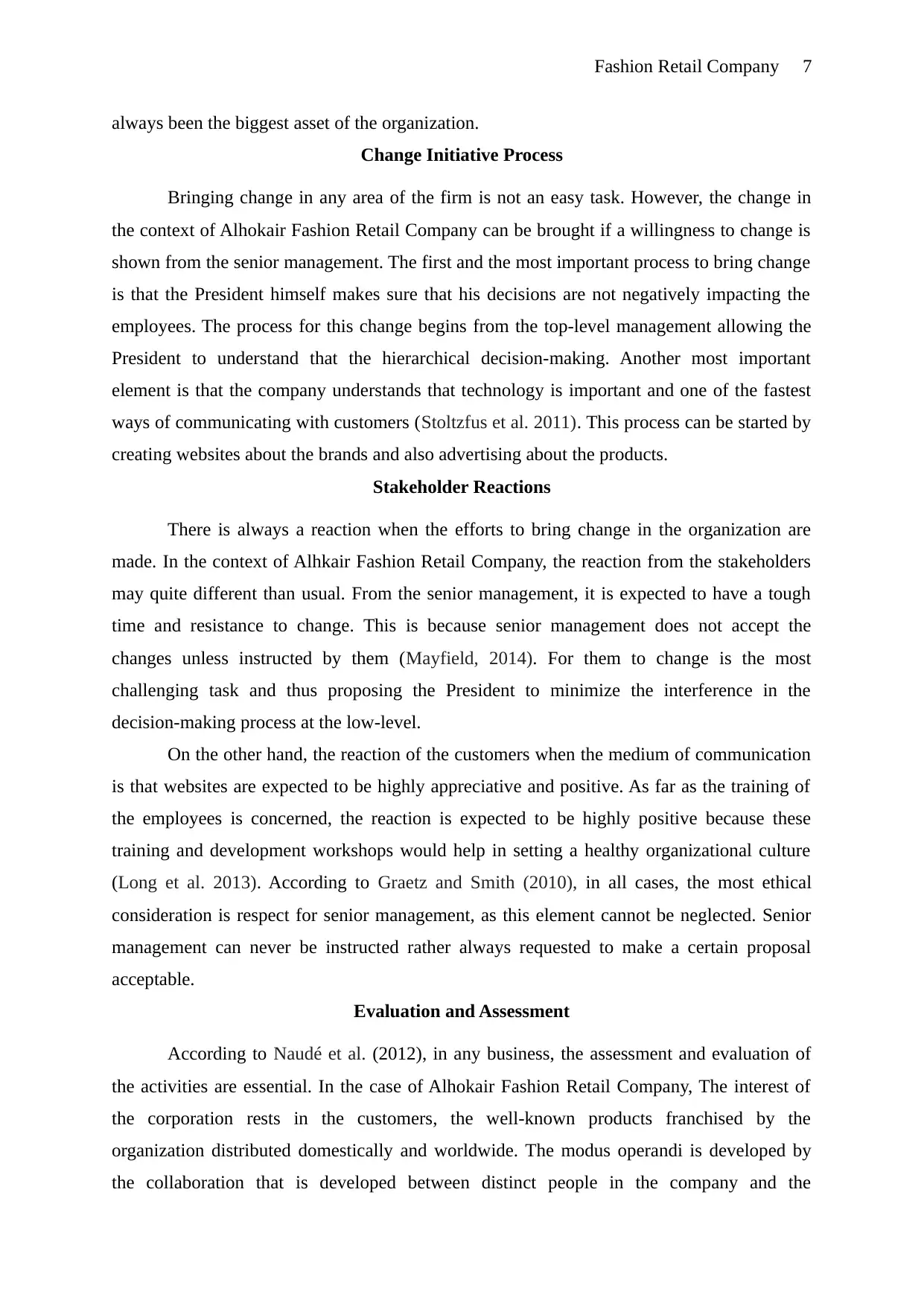
Fashion Retail Company 7
always been the biggest asset of the organization.
Change Initiative Process
Bringing change in any area of the firm is not an easy task. However, the change in
the context of Alhokair Fashion Retail Company can be brought if a willingness to change is
shown from the senior management. The first and the most important process to bring change
is that the President himself makes sure that his decisions are not negatively impacting the
employees. The process for this change begins from the top-level management allowing the
President to understand that the hierarchical decision-making. Another most important
element is that the company understands that technology is important and one of the fastest
ways of communicating with customers (Stoltzfus et al. 2011). This process can be started by
creating websites about the brands and also advertising about the products.
Stakeholder Reactions
There is always a reaction when the efforts to bring change in the organization are
made. In the context of Alhkair Fashion Retail Company, the reaction from the stakeholders
may quite different than usual. From the senior management, it is expected to have a tough
time and resistance to change. This is because senior management does not accept the
changes unless instructed by them (Mayfield, 2014). For them to change is the most
challenging task and thus proposing the President to minimize the interference in the
decision-making process at the low-level.
On the other hand, the reaction of the customers when the medium of communication
is that websites are expected to be highly appreciative and positive. As far as the training of
the employees is concerned, the reaction is expected to be highly positive because these
training and development workshops would help in setting a healthy organizational culture
(Long et al. 2013). According to Graetz and Smith (2010), in all cases, the most ethical
consideration is respect for senior management, as this element cannot be neglected. Senior
management can never be instructed rather always requested to make a certain proposal
acceptable.
Evaluation and Assessment
According to Naudé et al. (2012), in any business, the assessment and evaluation of
the activities are essential. In the case of Alhokair Fashion Retail Company, The interest of
the corporation rests in the customers, the well-known products franchised by the
organization distributed domestically and worldwide. The modus operandi is developed by
the collaboration that is developed between distinct people in the company and the
always been the biggest asset of the organization.
Change Initiative Process
Bringing change in any area of the firm is not an easy task. However, the change in
the context of Alhokair Fashion Retail Company can be brought if a willingness to change is
shown from the senior management. The first and the most important process to bring change
is that the President himself makes sure that his decisions are not negatively impacting the
employees. The process for this change begins from the top-level management allowing the
President to understand that the hierarchical decision-making. Another most important
element is that the company understands that technology is important and one of the fastest
ways of communicating with customers (Stoltzfus et al. 2011). This process can be started by
creating websites about the brands and also advertising about the products.
Stakeholder Reactions
There is always a reaction when the efforts to bring change in the organization are
made. In the context of Alhkair Fashion Retail Company, the reaction from the stakeholders
may quite different than usual. From the senior management, it is expected to have a tough
time and resistance to change. This is because senior management does not accept the
changes unless instructed by them (Mayfield, 2014). For them to change is the most
challenging task and thus proposing the President to minimize the interference in the
decision-making process at the low-level.
On the other hand, the reaction of the customers when the medium of communication
is that websites are expected to be highly appreciative and positive. As far as the training of
the employees is concerned, the reaction is expected to be highly positive because these
training and development workshops would help in setting a healthy organizational culture
(Long et al. 2013). According to Graetz and Smith (2010), in all cases, the most ethical
consideration is respect for senior management, as this element cannot be neglected. Senior
management can never be instructed rather always requested to make a certain proposal
acceptable.
Evaluation and Assessment
According to Naudé et al. (2012), in any business, the assessment and evaluation of
the activities are essential. In the case of Alhokair Fashion Retail Company, The interest of
the corporation rests in the customers, the well-known products franchised by the
organization distributed domestically and worldwide. The modus operandi is developed by
the collaboration that is developed between distinct people in the company and the
Paraphrase This Document
Need a fresh take? Get an instant paraphrase of this document with our AI Paraphraser
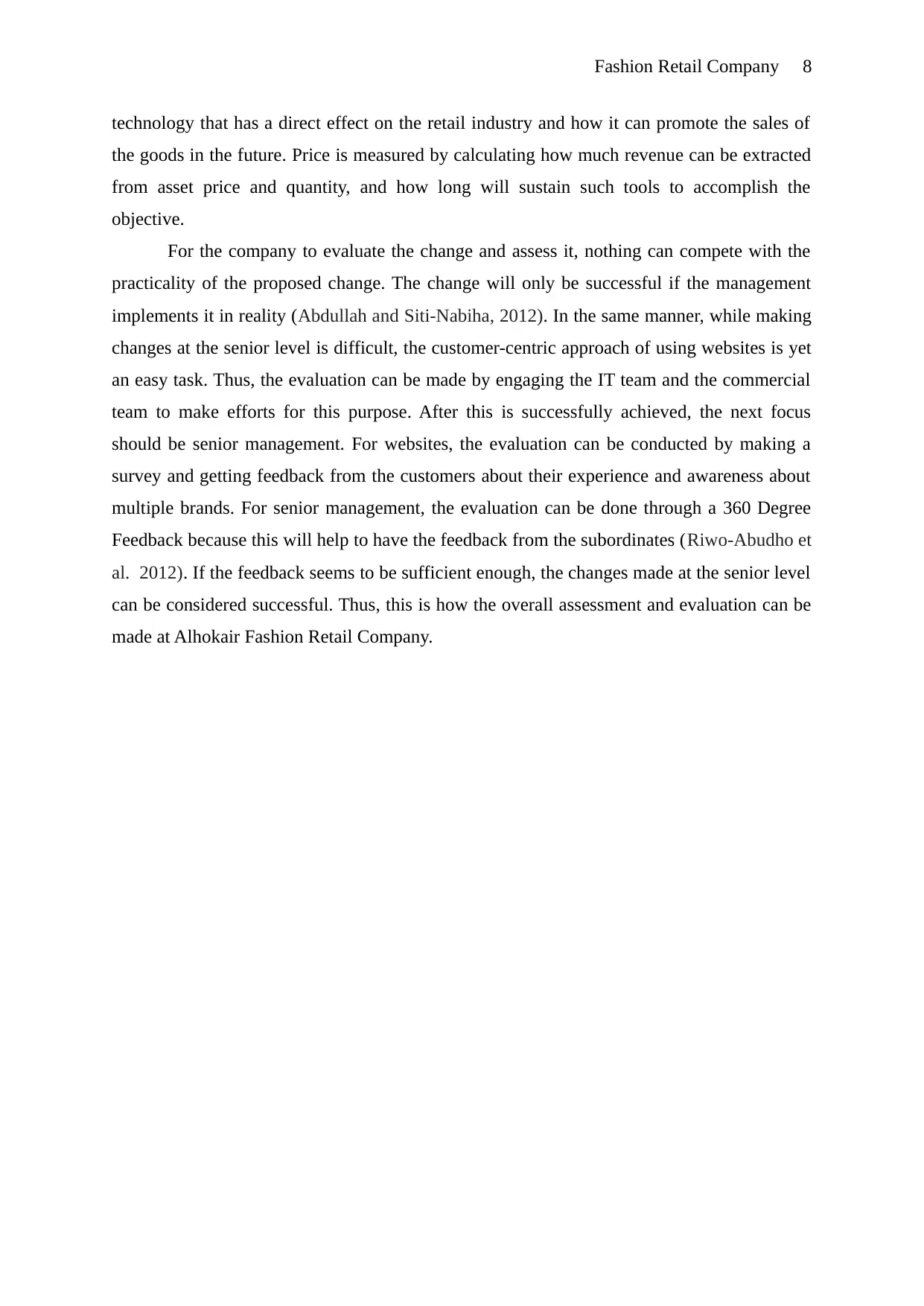
Fashion Retail Company 8
technology that has a direct effect on the retail industry and how it can promote the sales of
the goods in the future. Price is measured by calculating how much revenue can be extracted
from asset price and quantity, and how long will sustain such tools to accomplish the
objective.
For the company to evaluate the change and assess it, nothing can compete with the
practicality of the proposed change. The change will only be successful if the management
implements it in reality (Abdullah and Siti-Nabiha, 2012). In the same manner, while making
changes at the senior level is difficult, the customer-centric approach of using websites is yet
an easy task. Thus, the evaluation can be made by engaging the IT team and the commercial
team to make efforts for this purpose. After this is successfully achieved, the next focus
should be senior management. For websites, the evaluation can be conducted by making a
survey and getting feedback from the customers about their experience and awareness about
multiple brands. For senior management, the evaluation can be done through a 360 Degree
Feedback because this will help to have the feedback from the subordinates (Riwo-Abudho et
al. 2012). If the feedback seems to be sufficient enough, the changes made at the senior level
can be considered successful. Thus, this is how the overall assessment and evaluation can be
made at Alhokair Fashion Retail Company.
technology that has a direct effect on the retail industry and how it can promote the sales of
the goods in the future. Price is measured by calculating how much revenue can be extracted
from asset price and quantity, and how long will sustain such tools to accomplish the
objective.
For the company to evaluate the change and assess it, nothing can compete with the
practicality of the proposed change. The change will only be successful if the management
implements it in reality (Abdullah and Siti-Nabiha, 2012). In the same manner, while making
changes at the senior level is difficult, the customer-centric approach of using websites is yet
an easy task. Thus, the evaluation can be made by engaging the IT team and the commercial
team to make efforts for this purpose. After this is successfully achieved, the next focus
should be senior management. For websites, the evaluation can be conducted by making a
survey and getting feedback from the customers about their experience and awareness about
multiple brands. For senior management, the evaluation can be done through a 360 Degree
Feedback because this will help to have the feedback from the subordinates (Riwo-Abudho et
al. 2012). If the feedback seems to be sufficient enough, the changes made at the senior level
can be considered successful. Thus, this is how the overall assessment and evaluation can be
made at Alhokair Fashion Retail Company.
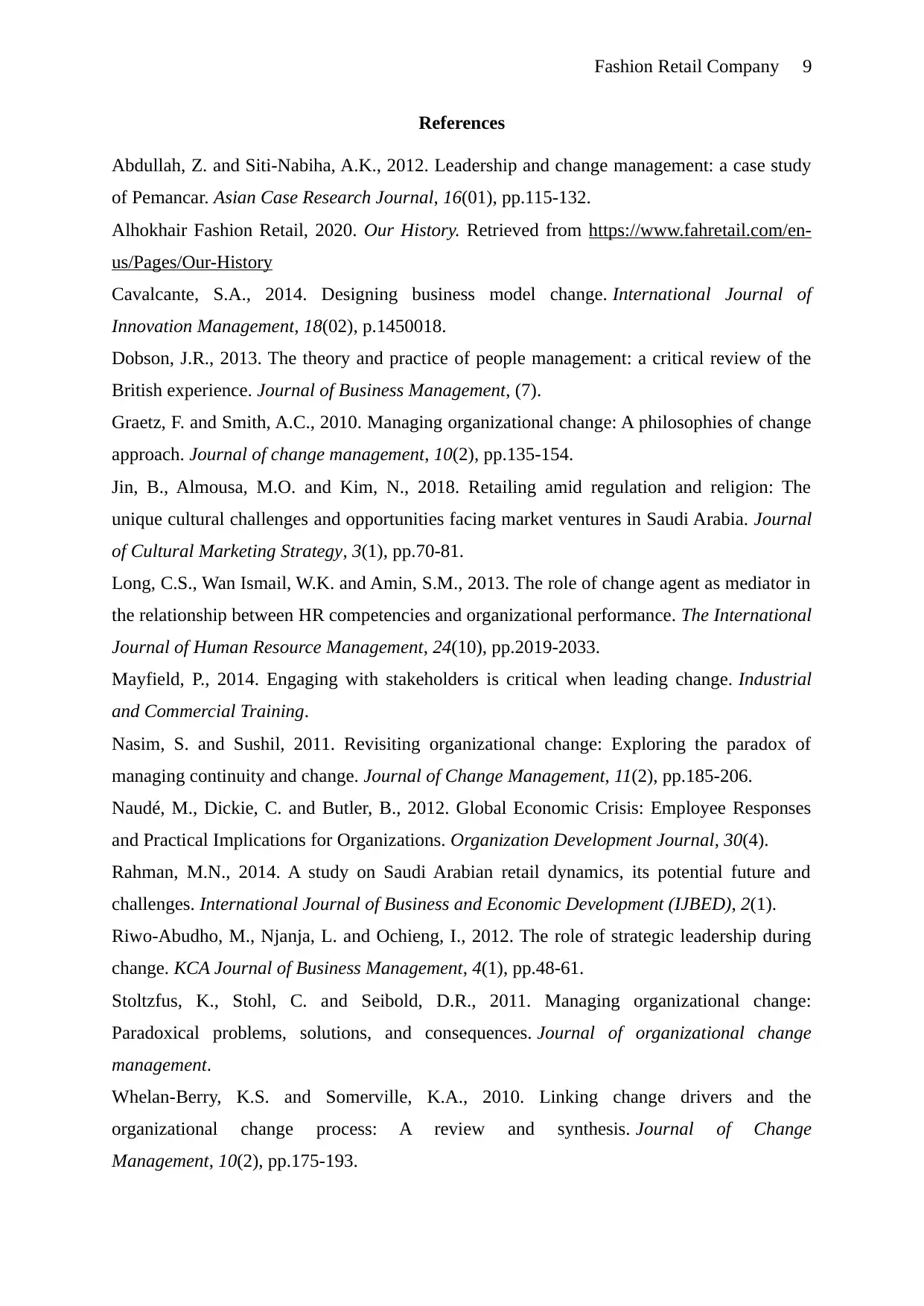
Fashion Retail Company 9
References
Abdullah, Z. and Siti-Nabiha, A.K., 2012. Leadership and change management: a case study
of Pemancar. Asian Case Research Journal, 16(01), pp.115-132.
Alhokhair Fashion Retail, 2020. Our History. Retrieved from https://www.fahretail.com/en-
us/Pages/Our-History
Cavalcante, S.A., 2014. Designing business model change. International Journal of
Innovation Management, 18(02), p.1450018.
Dobson, J.R., 2013. The theory and practice of people management: a critical review of the
British experience. Journal of Business Management, (7).
Graetz, F. and Smith, A.C., 2010. Managing organizational change: A philosophies of change
approach. Journal of change management, 10(2), pp.135-154.
Jin, B., Almousa, M.O. and Kim, N., 2018. Retailing amid regulation and religion: The
unique cultural challenges and opportunities facing market ventures in Saudi Arabia. Journal
of Cultural Marketing Strategy, 3(1), pp.70-81.
Long, C.S., Wan Ismail, W.K. and Amin, S.M., 2013. The role of change agent as mediator in
the relationship between HR competencies and organizational performance. The International
Journal of Human Resource Management, 24(10), pp.2019-2033.
Mayfield, P., 2014. Engaging with stakeholders is critical when leading change. Industrial
and Commercial Training.
Nasim, S. and Sushil, 2011. Revisiting organizational change: Exploring the paradox of
managing continuity and change. Journal of Change Management, 11(2), pp.185-206.
Naudé, M., Dickie, C. and Butler, B., 2012. Global Economic Crisis: Employee Responses
and Practical Implications for Organizations. Organization Development Journal, 30(4).
Rahman, M.N., 2014. A study on Saudi Arabian retail dynamics, its potential future and
challenges. International Journal of Business and Economic Development (IJBED), 2(1).
Riwo-Abudho, M., Njanja, L. and Ochieng, I., 2012. The role of strategic leadership during
change. KCA Journal of Business Management, 4(1), pp.48-61.
Stoltzfus, K., Stohl, C. and Seibold, D.R., 2011. Managing organizational change:
Paradoxical problems, solutions, and consequences. Journal of organizational change
management.
Whelan-Berry, K.S. and Somerville, K.A., 2010. Linking change drivers and the
organizational change process: A review and synthesis. Journal of Change
Management, 10(2), pp.175-193.
References
Abdullah, Z. and Siti-Nabiha, A.K., 2012. Leadership and change management: a case study
of Pemancar. Asian Case Research Journal, 16(01), pp.115-132.
Alhokhair Fashion Retail, 2020. Our History. Retrieved from https://www.fahretail.com/en-
us/Pages/Our-History
Cavalcante, S.A., 2014. Designing business model change. International Journal of
Innovation Management, 18(02), p.1450018.
Dobson, J.R., 2013. The theory and practice of people management: a critical review of the
British experience. Journal of Business Management, (7).
Graetz, F. and Smith, A.C., 2010. Managing organizational change: A philosophies of change
approach. Journal of change management, 10(2), pp.135-154.
Jin, B., Almousa, M.O. and Kim, N., 2018. Retailing amid regulation and religion: The
unique cultural challenges and opportunities facing market ventures in Saudi Arabia. Journal
of Cultural Marketing Strategy, 3(1), pp.70-81.
Long, C.S., Wan Ismail, W.K. and Amin, S.M., 2013. The role of change agent as mediator in
the relationship between HR competencies and organizational performance. The International
Journal of Human Resource Management, 24(10), pp.2019-2033.
Mayfield, P., 2014. Engaging with stakeholders is critical when leading change. Industrial
and Commercial Training.
Nasim, S. and Sushil, 2011. Revisiting organizational change: Exploring the paradox of
managing continuity and change. Journal of Change Management, 11(2), pp.185-206.
Naudé, M., Dickie, C. and Butler, B., 2012. Global Economic Crisis: Employee Responses
and Practical Implications for Organizations. Organization Development Journal, 30(4).
Rahman, M.N., 2014. A study on Saudi Arabian retail dynamics, its potential future and
challenges. International Journal of Business and Economic Development (IJBED), 2(1).
Riwo-Abudho, M., Njanja, L. and Ochieng, I., 2012. The role of strategic leadership during
change. KCA Journal of Business Management, 4(1), pp.48-61.
Stoltzfus, K., Stohl, C. and Seibold, D.R., 2011. Managing organizational change:
Paradoxical problems, solutions, and consequences. Journal of organizational change
management.
Whelan-Berry, K.S. and Somerville, K.A., 2010. Linking change drivers and the
organizational change process: A review and synthesis. Journal of Change
Management, 10(2), pp.175-193.
⊘ This is a preview!⊘
Do you want full access?
Subscribe today to unlock all pages.

Trusted by 1+ million students worldwide
1 out of 9
Related Documents
Your All-in-One AI-Powered Toolkit for Academic Success.
+13062052269
info@desklib.com
Available 24*7 on WhatsApp / Email
![[object Object]](/_next/static/media/star-bottom.7253800d.svg)
Unlock your academic potential
Copyright © 2020–2025 A2Z Services. All Rights Reserved. Developed and managed by ZUCOL.





